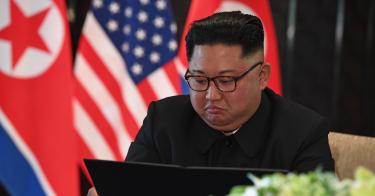It’s been just more than two years since President Donald Trump’s 2018 historic and unorthodox meeting with North Korean leader Kim Jong-un. Trump set aside the consensus of experts that North Korea should first commit to detailed denuclearization steps prior to Washington accepting Pyongyang’s long-standing demand for the first bilateral summit meeting. After the meeting, Trump exclaimed that “there is no longer a nuclear threat from North Korea” and that “total denuclearization [is] already starting to take place.”
The euphoric claim of breakthroughs were premature. There has been no progress toward denuclearization nor any degradation of the North Korean military threat to the United States and its allies. Before North Korea pulled the plug on negotiations, U.S. officials admitted that the two sides hadn’t even agreed on simple terms such as “denuclearization” or “Korean Peninsula,” let alone the sequencing, linkages, and timeline for achieving it.
Since Singapore, North Korea has augmented and refined its nuclear and missile arsenals. Satellite imagery reveals Pyongyang has produced additional ICBMs capable of reaching the United States and expanded and refined production facilities for fissile material and warheads, missiles, and mobile missile launchers. The regime also likely has produced another 10 or more nuclear weapons’ worth of fissile material, given expert assessments that North Korea can produce seven to 12 annually.
In 2019, Pyongyang unveiled five new weapons systems, some possibly nuclear-capable, that enhance the regime’s ability to attack South Korea and U.S. forces stationed there. Last year, the regime launched 26 missiles, the most violations of U.N. resolutions ever in a year. North Korean officials have warned the country will unveil a new strategic weapon and recently threatened unspecified military action against South Korea. Just this week, North Korea blew up a liaison office in the city of Kaesong that served as an embassy of sorts for the two countries, who are still technically at war.
President Trump has lauded his personal relationship with Kim Jong-un. However, in recent months, Pyongyang shifted from positive depictions of the relationship to describing it as separate, then irrelevant to the stalled nuclear negotiations. This month, the North Korean foreign minister declared there was no utility to maintaining that relationship.
The North Korean nuclear problem has bedeviled the United States for decades. President Trump was willing to test the hypothesis pushed by engagement advocates, that U.S. acquiescence to a meeting between the leaders would cut the Gordian knot of stalled negotiations. But despite three meetings, President Trump’s top-down approach of summit diplomacy has not been any more effective than previous efforts to curtail Pyongyang’s nuclear ambitions.
Unfortunately, there has been a cost to the approach of the past two years. The Trump administration undercut all three pillars of its ‘maximum pressure’ policy, namely sanctions pressure, military deterrence, and diplomatic isolation. At the time of the Singapore summit, President Trump announced that he no longer wanted to use the ‘maximum pressure’ moniker and that he had chosen not to sanction 300 North Korean entities that were violating U.S. financial laws.
The White House also didn’t take action against 12 Chinese banks that Congress believed were facilitating North Korea’s sanctions violations. Nor has the administration imposed any fines on Chinese banks for money laundering for North Korea. (Previous administrations had imposed $8 billion in fines on British and French banks for money laundering for Iran.)
After the Singapore summit, President Trump announced an end to some military exercises in South Korea. Since then, numerous allied exercises have been canceled with constraints imposed on others. Military experts, like Heritage Foundation analyst Lt. Gen. (Ret.) Thomas Spoehr, warned of a potential degradation in allied military deterrence and defense capabilities.
Strong alliances are another component of military deterrence. Yet, Washington is currently deadlocked in negotiations over South Korean compensation for the cost of stationing U.S. forces there. In the previous negotiation, Trump directed U.S. negotiators to seek “cost plus 50 percent” and began the current talks with a demand for a figure far higher than the U.S. had previously told South Korea was the cost of stationing U.S. forces there. While the U.S. often seeks to have allies pay a portion of the costs of having troops stationed within their borders, seeking to make a profit off American forces overseas is inconsistent with American values, principles, and commitments.
Sitting in Seoul or Pyongyang or Tokyo, it is sometimes difficult to know whether the U.S. wants to keep its troops in South Korea at any price. Richard Grenell, former ambassador to Germany, commented this week that President Trump was “very clear” that he wants to bring U.S. troops home from South Korea and other allied nations because of the cost.
Reducing U.S. forces deployed to the Pacific would make America weaker on the world stage. It would drive a wedge between Washington and its allies in Asia, risk triggering stronger actions by North Korea, China, and Russia, and exacerbate already growing concerns in Seoul and Tokyo about the continued viability of the United States as an ally.
Kim Jong-un has been diplomatically isolated, in part, because he is on the U.S. sanctions list for human rights violations. The U.N. Commission of Inquiry concluded the regime’s human rights abuses were so widespread, systemic, and egregious that they constituted “crimes against humanity.” But, in the last two years, the Trump administration has embraced Kim as “courageous,” “honorable,” and declared that he “loves his people.”
North Korea may well be an intractable problem as long as the Kim regime remains in power. But the best policy for the U.S. is a comprehensive long-term strategy of diplomacy, fully implementing U.N. resolutions and U.S. laws, upholding America’s human rights principles, and strong deterrence until the nuclear, missile, and conventional force threat is reduced.
This piece originally appeared in The Dispatch



